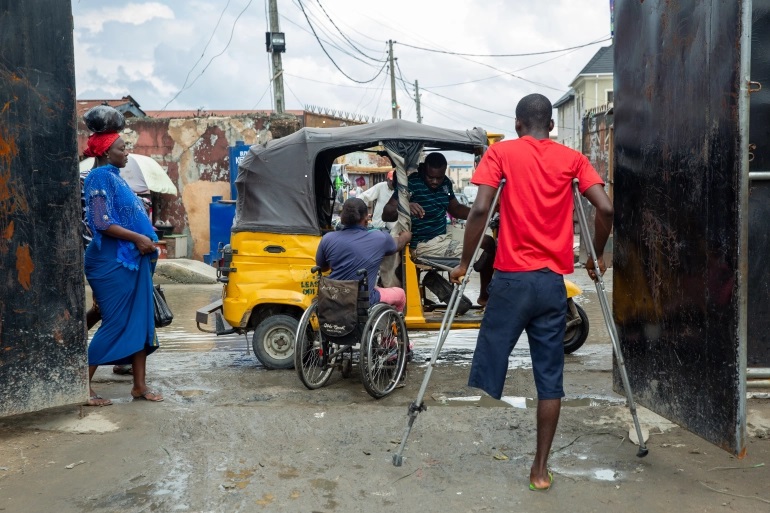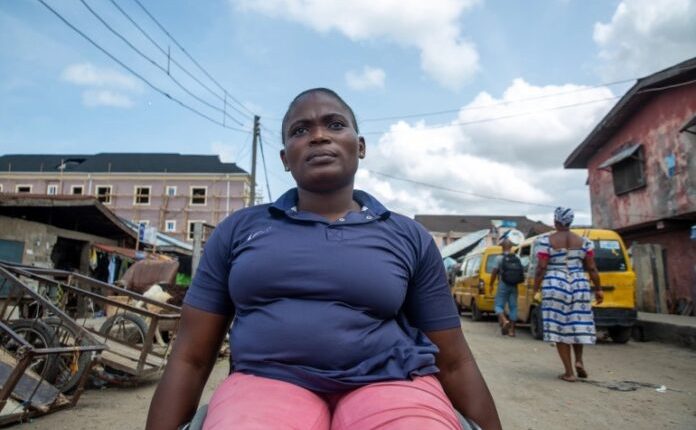
The Albino Foundation Public Notice
By Viktorija Mickute and Sarah Kim,
A close look into the state of accessibility in Nigeria’s largest city.
Around the world, city populations are soaring. By 2050, some 68 percent of the world’s population is expected to live in urban areas, up from today’s 55 percent.
Just three countries are responsible for about one-third of this growth – China, India, and Nigeria. But as cities expand, a large proportion of society continues to be marginalised and excluded — people with disabilities.Unlike any other marginalised group, anyone can become a member of the disability community at any point in their life.
People can develop a physical disability because of an accident, illness, or simply, old age.Of the more than one billion people who have some form of disability, 80 percent live in the developing world.
According to the United Nations, people with disabilities include those who have “long-term physical, mental, intellectual or sensory impairments, which in interaction with various barriers, may hinder their full and effective participation in society on an equal basis with others”.Nigeria’s Lagos, with its 15 million residents, is one of Africa’s largest cities and is among the fastest growing in the world.
Notoriously congested roads, chaotic traffic and widespread poverty makes Lagos a tough city to live in and navigate. But add a lack of access to public transport and getting around becomes even tougher for people with disabilities.So what does it mean to live in Lagos, one of the world’s megacities, with a disability?
An aerial photograph of a congested road in Lagos. The middle of the road is crowded with yellow buses and the sides of it with people.
I’m Lagos, people compete for space on roads congested with oil tankers, cars, bikes and tricycles

Public transport accounts for 98 percent of the traffic, according to Professor Gbadebo Odewumi, the dean of the school of transport at Lagos State University.
But it is disorganised, largely unreliable and highly inaccessible for people with disabilities.There are 75,000 yellow unregulated privately owned minibuses, popularly called “danfos”, in Lagos. These are 20th-century 14-seater Volkswagen buses with seats and backrests without padding and they run on fume-emitting engines. The boarding experience of passengers with disabilities largely comes down to the driver and conductor duo running the bus: they decide who they will take on board, who they will assist and who they will wait for.
Aiming to improve the formal transport sector, in 2008 the Lagos government entered the public transport business with Africa’s first-ever Bus Rapid Transit (BRT) system, a bus service that runs frequently and is designed to transport a large number of people. The buses themselves are comfortable and have specially reserved seats for people with disabilities. However, there are only 474 of them and they only go on main highways.
The ramps for wheelchair users are often either non-functional or not used, according to people in Lagos with disabilities. Staff are frequently not trained to help disabled passengers board, while other riders are not always sensitive to the needs of people in wheelchairs. For example, seats earmarked for people with disabilities are taken by able-bodied passengers.
Lagos has other privately owned transportation services, such as motorbikes and tricycles, known as keke. They can be especially convenient for some people with disabilities, such as people with visual or hearing impairments, as they can be arranged for pick up and drop off. However, these are not that useful for wheelchair users, for example, since there is no place to store the chair or other medical devices.
The least affordable mode of transport is e-hailing (Bolt or Uber) and regular taxis. A 40km trip with Bolt or Uber costs about 5,000 naira or $12. Rideshare and cab options are not feasible for many people with disabilities, in particular, those who live under the poverty line, that is, living on less than $1 a day. Forty percent of Nigeria’s population live in poverty. Nine out of 10 Nigerians with disabilities are estimated to live below the poverty line.
Olajumoke Olajide, 26, boards a tricycle to travel to the national stadium where she trains [Ebunoluwa Akinbo/Al Jazeera]
Plans for safer roads, accessible transport.
Using the current public transport is a leap of faith for many people with disabilities. However, the Lagos Metropolitan Area Transport Authority in 2018 released a new non-motorised transport policy (NMT) to reduce congestion, injuries and deaths on the roads, noise and air pollution. The policy says “mobility planning should focus on people, not vehicles” and aims to prioritise walking, cycling and public transport over the use of cars.
Pavements are non-existent in many places so pedestrians and vehicles share roads where drivers can drive dangerously, and even against traffic. By creating new and upgraded footpaths, the policy aims to reduce pedestrian accidents and deaths.
The NMT also includes people with disabilities with the plans to incorporate ramps, tactile pavements with textured ground surfaces to warn and guide visually impaired people and other features at public transport stations.
As part of modernising the city’s transit system, the Lagos government is also building a light rail. The first two of the seven proposed lines are scheduled to become operational by the start of 2023. Lagos governor Babajide Sanwo-Olu has said it will be part of a wider system that will be “attractive, convenient, affordable, accessible and will reduce urban transportation challenges”.
Initiatives such as the NMT and laws including the Lagos State Special Peoples’ Law, which stipulates that public transport should be easily accessible for people with disabilities, and the federal Discrimination Against Persons with Disabilities (Prohibition) Act, assist and protects people with disabilities. However, one of the biggest challenges is the lack of implementation. For instance, the NMT committee to implement changes was inaugurated only three years after the announcement of the policy and there is no set date for completion.
Olajumoke boards an inaccessible keke napep – a yellow and black tricycle. A man with an amputated leg using crutches and a woman watch.
Inaccessible cities: Lagos
Making cities accessible for people of all abilities is the first step towards true equity and inclusion.
To make Lagos more accessible, the city needs a taxi service that can take people with disabilities from their houses to the nearest accessible bus station, while public transport should become more accessible in line with the Lagos State Special People’s Law.
Without options to freely and independently move around the city, people with disabilities are forced to stay home and are invisible in Lagos’ public life.
Stuck in a vicious cycle, people with disabilities lack access to education, healthcare, employment, housing and systems of social protection. They face stigma, discrimination and even violence.
For Kelechukwu Ogu, a blind journalist from Lagos, being able to move and walk around Lagos freely and safely is critical. Over the years, his foot has slipped into gutters on the street and the possibility of getting stuck – and being hit by a vehicle – fills him with anxiety. Once, when he was 10 years old, he fell waist-deep into an open drain. No one stopped to help him out.“
My interaction with open drainages and the fear of being knocked down by a bike or car has trained me to endure hunger and deprivation while waiting for a sibling or neighbour to help me make purchases,” says Kelechukwu.
Learn more about life for people with disabilities in Lagos by joining disabled athlete Olajumoke Olajide as she navigates her city in “Inaccessible Cities,” the latest interactive web experience by AJ Contrast, Al Jazeera Digital’s media innovation studio.
To understand the state of accessibility in two other megacities, join Rebecca Lamorte, a former City Council candidate from New York City, United States, and Nidhi Goyal, a comedian and disability rights activist from Mumbai, India.
Qualitative Magazine



